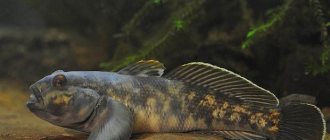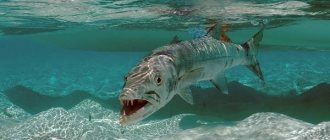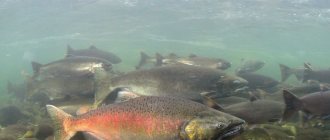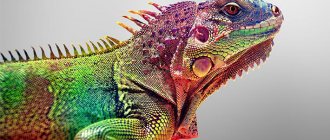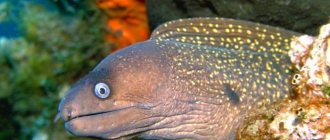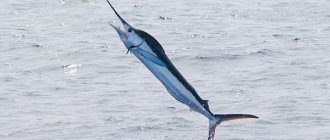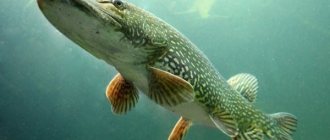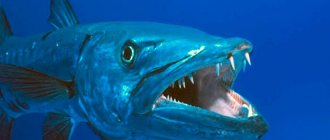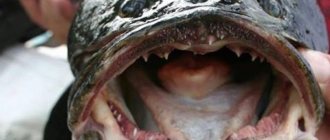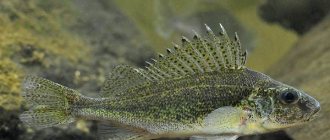Salmon is not the name of a fish or a specific valuable species, but of an entire family. Coho salmon, char, chum salmon, pink salmon, trout are all representatives of salmonids, or salmon. If this word is applied to a specific species, it usually means salmon - a rare species in the wild, which, however, can often be found in stores due to industrial breeding.
Which fish tastes better?
- Coho salmon 33%, 1554 votes
1554 votes 33%1554 votes - 33% of all votes
- Salmon 29%, 1387 votes
1387 votes 29%
1387 votes - 29% of all votes
- Trout 27%, 1260 votes
1260 votes 27%
1260 votes - 27% of all votes
- Chum salmon 8%, 395 votes
395 votes 8%
395 votes - 8% of all votes
- Pink salmon 3%, 123 votes
123 votes 3%
123 votes - 3% of all votes
Total votes: 4719
19.12.2019
- Coho salmon 33%, 1554 votes
1554 votes 33%1554 votes - 33% of all votes
- Salmon 29%, 1387 votes
1387 votes 29%
1387 votes - 29% of all votes
- Trout 27%, 1260 votes
1260 votes 27%
1260 votes - 27% of all votes
- Chum salmon 8%, 395 votes
395 votes 8%
395 votes - 8% of all votes
- Pink salmon 3%, 123 votes
123 votes 3%
123 votes - 3% of all votes
Total votes: 4719
19.12.2019
×
You or from your IP have already voted.
Description of the species
The salmon family is very diverse. It includes small and giant fish, they can have red or white meat, and they can live in salt or fresh water. But they all have one thing in common:
- breeding only in fresh water bodies, although adults can live in the ocean;
- spotted body coloration, for which the family got its name (the ancient Indo-European root “lah” means “spotted”);
- characteristic features of the body structure;
- large eggs;
- high adaptability to new external conditions, which makes it possible to artificially grow these fish far from their natural habitats;
- high gastronomic properties, each of the salmon is a delicacy.
Atlantic
The genus of Atlantic salmon includes only one species - salmon. It spawns on the east coast of the USA and Canada, as well as on the west coast of Europe from the latitude of Spain to the Baltic, White and Barents seas. In nature, due to predatory fishing, it is rare.
Since Atlantic salmon is very popular in gastronomy, salmon is often farmed artificially. The Norwegians have been especially successful in this; their salmon has long become a brand on the world market.
In Russia, salmon farming is unprofitable due to the unfavorable environment in our seas. The water temperature in them is 2 degrees lower than in Norway, the fry grow much slower, and the economic meaning of such breeding is lost.
The species exists in two forms – migratory and lacustrine. The nature of the passage form is extremely interesting. Unlike most other anadromous salmon, salmon can spawn 3-5 times, rather than once. Some fish return to rivers from feeding not yet fully mature, and grow in the river for a whole year. Their eggs or milt ripen, but during this year the salmon are in spawning mode and do not eat.
Some males do not leave to feed at all, remaining near the spawning grounds. They turn out to be much smaller than the males who fed in the sea, but they fertilize eggs no worse, and sometimes even better: they do not interfere with intraspecific competition between large males, and manage to fertilize more eggs.
Pacific
This genus unites all anadromous salmon that feed in the Pacific Ocean. This:
- pink salmon;
- red salmon;
- chum salmon;
- coho salmon;
- Chinook salmon
Until recently, rainbow trout also belonged to this genus.
Subfamily Salmonidae
This is a broad category that includes freshwater lenok and taimen, char, representatives of the Pacific salmon, noble salmon - numerous varieties of trout and salmon.
All salmon, except chum salmon and pink salmon, have anadromous and residential (freshwater) forms, as well as dwarf males that do not go to sea, although they belong to the anadromous variety.
During feeding time at sea, the appearance of all salmon is similar: silver-gray with black spots. But when the fish goes to spawn, striking differences appear, thanks to which even a non-specialist can distinguish one salmon from another.
Most salmon spawn only once in their lives, then the stock dies, providing nutrients to future young animals. The exception is salmon, both the Atlantic and Kamchatka varieties. She can spawn 3-5 times.
The most numerous representative of salmon is pink salmon. This is a small fish weighing 1.5-2 kg and 50-60 cm long. In fish going to spawn, the jaws are bent in the form of a beak, and in males a hump appears. Most often, the life expectancy of pink salmon is short, only 1.5 years. But if the fish for some reason missed spawning, it can live up to 3 years. Pink salmon, of all salmon, is the least attached to spawning grounds, and may well swim into foreign areas. This happens because at sea the stocks hatched from eggs in Asia and North America mix and go to spawn in newly formed groups.
Chum salmon is also a numerous species. It is distinguished by the presence of transverse red-green and black stripes during the mating season. At this time, males notice the growth of teeth, due to which their mouth stops closing. This is a large fish, about 1 m long and weighing up to 14 kg, although individuals up to 78 cm long and weighing up to 5 kg are more common. The autumn form is larger, and the spring form is smaller. Fish breed from 3 to 10 years old; most of those going to spawn are 5 years old.
Sockeye salmon is clearly different from other salmon in the color of its meat: it is not pink, but bright red. Otherwise, outside the mating season, it resembles chum salmon. The only difference is in the rigidity of the caudal fin: a chum salmon can be lifted by the tail with one hand, but a sockeye salmon cannot: its caudal fin easily folds and slips out of the hand. But the sockeye salmon going to spawn is recognizable even from the description: its skin is completely red, as in the photo. This and the color of the meat determined the unofficial name of sockeye salmon - red fish.
There is freshwater sockeye salmon, or kokanee. It is smaller, only 28 cm, weighing up to half a kilogram.
The migratory form has dwarf individuals that remain on the spawning grounds until the mating season, which occurs at 3-4 years of age. Unlike other salmon, dwarf sockeye salmon have both males and females. Sockeye salmon usually return to the same spawning area where they hatched.
Coho salmon is a fish measuring 40-80 cm, weighing 6-8 kg. The mating color is dark brown or crimson; in males the upper jaw changes, forming a “beak”, as in the photo. The length of an adult fish is 70-80 cm, weight 6-8 kg. It spawns only in running water, the breeding age is 4 years, but this fish goes to sea quite late - at 2, sometimes at 4 years of life. It is rarely found on sale, since the number of coho salmon is relatively small.
Chinook salmon is the largest representative of the subfamily, which is informally called “king salmon.” Its length is up to 1.5 m, and its weight is more than 50 kg, although in Kamchatka meter-long individuals weighing 10-15 kg are more common. Spawning occurs at 4-7 years. The industrial catch is small, only 1-2 thousand tons.
Loaches are a large genus of salmon with small scales, which includes about a dozen species with different habitats. All loaches have freshwater and anadromous forms. These fish can spawn several times while remaining alive.
The commercial value of this fish is small, despite the high taste of the meat. The average size of caught fish is 40-50 cm, weight 1.5-2 kg. Loaches mature slowly; they reach the age of migration at 2-9 years.
Each year, only part of the school takes part in breeding, but non-breeding individuals still return to the spawning grounds.
Subfamily Whitefish
Includes valuable species of freshwater fish - whitefish, muksun, omul, vendace and others.
Muksun is a delicious fish. It lives in the north of Siberia - in rivers, lakes and desalinated sea bays. It reproduces easily in captivity, thanks to which the wild form is not in danger of extinction. This fish weighs 6-8 kg (there are specimens up to 13 kg), length – up to 75 cm. The color is blue, darker on the back and lighter on the belly.
Omul is divided into two groups - Arctic and more valuable Baikal.
Arctic omul is a northern salmon with an average length of 26-40 cm and a weight of up to 1, less often 3-4 kg. It lives up to 16 years, although ten-year-old individuals most often end up on the table. The main habitat is the Lena River basin. Omul is able to live in difficult conditions. Among the areas where this salmon lives, there are those in which the water salinity reaches 20-22 and even higher. In summer, omul can be found at fairly high latitudes, right up to the New Siberian Islands. The spawning of omul occurs in the same way as that of salmon, but it does not always die after spawning; females can spawn 2-3 times during their life.
The Baikal omul is a smaller, up to 28 cm in length, relative of the Arctic, which during the last glaciation, 20 thousand years ago, ended up in Baikal, where it was then isolated. Now this fish is the pride of Baikal. Although in recent years the number of Baikal omul has decreased and quotas for its catch have been introduced. But thanks to the fact that one of the varieties of Baikal omul is successfully bred artificially, this fish can still be found on sale.
Peled, or cheese, is a fish about 50 cm long. It weighs 2-3 kg. Unlike other salmon, it perfectly tolerates the lack of oxygen in the water, so its habitat is lakes, and less often - channels. This fish avoids running waters. In winter it does not hibernate. It lives in rivers and lakes of the northern sea basins from the White to the East Siberian, and does not rise high to the sources.
Whitefish live in the same place as peled, additionally living in the Baltic region, Alaska and Canada. There is a unique species of Transbaikal whitefish, famous for spawning in the spring. Whitefish looks exceptionally diverse. Its dimensions range from 15 to 60 cm, weight – from 1 to 12 kg. There are semi-anadromous and lake varieties.
Subfamily Grayling
There is only one genus in this family of freshwater fish - grayling. It is very similar to salmon. Graylings look more beautiful and graceful, but their main difference is the large dorsal fin in males, with which they increase the efficiency of fertilization of eggs during spawning, directing water flows in a special way. Graylings live in lakes of Eurasia and North America.
Features of reproduction
In northern latitudes, fish go to spawn in the second half of September. This phenomenon occurs at temperatures not below zero. Salmon spawn in the southern regions from October to January. The water temperature is in the range of 3-13 degrees Celsius. Caviar is deposited in special depressions at the bottom of the reservoir, which the fish arranges independently. After this, the female sprinkles them with a mixture of sand and pebbles.
The behavior of salmon changes during spawning: they become more active and can jump out of the water to an impressive height. But immediately before the start of spawning, such behavior is rarely observed. As soon as it ends, the fish quickly loses weight. Not all individuals survive. They go deep into lakes or sea waters, but can remain in the river until spring.
Salmon do not go too far from the area where they laid their eggs. In the spring, young individuals appear that resemble pied trout in appearance. Young animals can spend from 1 to 5 years in the river. During this period, their body length reaches 18 cm. By this time, the characteristic spots disappear, and the color acquires a beautiful silvery tint. Increased feeding with active weight gain in salmon occurs in lakes and seas.
They become most active during spawning
Where does it live?
The natural habitat of salmon fish covers almost all the seas of the Northern Hemisphere, but plantations of anadromous species also exist in the Southern Hemisphere. This was made possible due to the high adaptability of salmon.
The main spawning grounds for migratory species are located in the rivers of Kamchatka, Sakhalin, Kuril and Alaska. Most freshwater species live in rivers and lakes of Siberia and the Far East, but one subspecies of taimen is also found in the Danube.
But feeding of migratory forms always occurs at sea. Therefore, it is not easy to say where salmon live.
Habitat and diet
Salmon lives in northern latitudes. Ishkhan, considered a delicacy of high value fish, swims in Lake Sevan. A resident of the Pacific waters, chum salmon is found not only in Russia, but also in the United States. Trout lives in European rivers, the Aral and Black Seas, and mazu lives in the Asian part of the Pacific Ocean. Taimen, distinguished by its large size, lives in Siberian rivers.
The basis of salmon nutrition is small fish and their young, mollusks, crustaceans, and worms. Some individuals do not refuse jellyfish and ctenophores. Salmon loves insect larvae. The moth can feed on sculpins and loaches. Depending on the time of year, the diet may differ.
They feed on live food
What does it eat?
All salmon are predators. Their food depends on their size. The newly hatched fry prey on zooplankton, the smallest aquatic animals. The fish grows, and its food becomes larger. First these are worms, crustaceans, and then fry of other species.
When salmon reach 15-25 cm in length, they form schools and go to the sea or to deeper freshwater bodies. Here he eats fish and other inhabitants of the upper layers of sea water.
When the time comes to return to their homeland for spawning, most species stop eating altogether. After all, having spawned, they will die, and there is no point in wasting energy on hunting. In addition, there is simply no food familiar to adult salmon in the upper reaches of the rivers.
The benefits and harms of salmon caviar
Salmon caviar is not just a wonderful delicacy. It also has some outstanding benefits and health benefits. Thus, one tablespoon of caviar contains more than 1 gram of healthy unsaturated fats.
In addition, it is also an excellent source of vitamin B12, which is responsible for creating red blood cells and helping the body utilize fatty acids. Selenium, the benefits of which are undeniable, is also found in caviar. It works as an antioxidant in conjunction with vitamin E to protect cells from damage caused by free radicals and other compounds in the body that can lead to heart disease or cancer.
Caviar is also rich in vitamins A and E, which are essential for cell growth and a healthy immune system. A tablespoon of caviar contains about one-tenth of the daily value of these compounds.
Salmon roe is also high in protein and low in trans fats and carbohydrates, which can be harmful when consumed in excess. This delicacy is also rich in potassium, which lowers blood pressure. Potassium is also thought to help prevent the accumulation of kidney stones, and some migraine sufferers find it helps relieve symptoms.
The harm of salmon caviar may lie in the fact that it has high cholesterol levels. The sodium content of the product is another drawback. The caviar is soaked in a saline solution during processing, which increases the content of this substance. The properties of this product are identical to those of salted fish. The benefits of such salmon are not in dispute, but excess salt reduces it somewhat.
Sea or river
Among salmon there are both freshwater and anadromous, or anadromous forms. Such fish hatch from eggs in fresh water bodies and go to sea to mature. When the time comes to reproduce, they return from the sea to the same body of water and even the same shallows where they themselves appeared. Pink salmon, sockeye salmon, chum salmon and many other salmon behave this way.
Sockeye salmon can remain living in fresh water bodies if there is enough food in them.
Therefore, from a biological point of view, salmon are not completely marine inhabitants. Gastronomy takes the opposite point of view, and for the cook, salmon caught at sea or at the mouth of a river on the way to spawn (salmon, chinook salmon, coho salmon) will be sea salmon, and freshwater trout will be river trout.
Few people know that freshwater species - trout, Baikal omul, taimen - also leave large rivers and lakes for small reservoirs or mountain streams during the spawning period.
The benefits and harms of smoked salmon
Smoked salmon has beneficial and harmful properties. Like fresh, it is a good source of protein, vitamins B and D, magnesium and selenium. High amounts of DHA and EPA help reduce the risk of heart disease and prevent macular degeneration and Alzheimer's disease.
On the other hand, smoked salmon has a higher dose of sodium. For example, 120 g of the product contains 666 mg of sodium, which is more than one-third of the daily value.
Before fish is smoked, it is treated by adding salt in the form of brine (a mixture of salt, water and spices) or salt crystals. Salt reduces the moisture content of salmon, which helps extend its shelf life. It also helps prevent the growth of germs that can cause food poisoning.
Most smoked salmon is cold smoked, meaning it is cooked at a temperature that is not hot enough to kill potentially harmful bacteria. Therefore, there may be harm from Listeria monocytogenes, a bacteria that can cause rare but serious food poisoning, especially among pregnant women, the elderly and people with weakened immune systems.
Hot smoked salmon is lighter in color and more fluffy. It is processed at a temperature of about 80 °C and is completely ready for consumption. Despite the heat treatment, it can also cause harm if technological processes are disrupted.
There is also concern that eating smoked foods may increase the risk of cancer. Smoked salmon contains nitrates and nitrites, by-products of smoking. Their harm lies in the fact that they can be converted in the body into N-nitroso compounds, which are carcinogenic. Thus, there are both benefits and harms of smoked salmon for the body.
Meat white or red
Housewives often say, meaning salmon: “red fish.” It would seem logical: salmon and literally all other migratory salmon have red meat. But sturgeon are actually called red fish, and not because of the color of the meat, it is creamy white. “Red” in the Old Russian language refers not only to scarlet and its shades, but also to beautiful (“red maiden”), indicating wealth, luxurious. Sturgeon has always been a product of the highest class, an attribute of the festive feasts of the nobility, one of the symbols of Rus'.
Interesting. The color of salmon meat depends on its species, the period in which the fish was caught, and the amount of shrimp in its diet.
It’s a paradox, but salmon are white fish. True, not all salmon, but only delicious representatives of this species with white meat - muksun, nelma, omul, whitefish.
Species that have red meat, and these are salmon, sockeye salmon, chinook salmon, pink salmon, chum salmon, coho salmon, trout and many others, which most people associate with “red fish,” are correctly called simply “salmon.”
Useful properties of salmon
Eating fish twice a week is said to be a great way to improve heart health. People who eat this product regularly are protected from developing a variety of conditions that can cause harm. Omega-3 reduces inflammation in the body. This process is the basis of many health problems, including diabetes, heart disease, some types of cancer and arthritis. Omega-3 properties can prevent blood clots that cause serious harm.
Some research also suggests that healthy fats may help slow cognitive problems such as Alzheimer's disease and age-related cognitive decline. In this regard, the benefits of salmon bellies, which contain the most fat, stand out.
For the heart and blood vessels
Eating salmon fish on a regular basis can protect against heart disease. This is due to the properties of salmon to increase Omega-3 in the blood, which can balance the elevated levels of Omega-6 fatty acids in the blood that occur in some people.
When the balance of the above two fatty acids is imbalanced, the risk of heart disease increases.
For the brain and nervous system
A growing number of studies show that including salmon in your diet can improve brain function. It reduces depressive symptoms, protects fetal brain health during pregnancy, reduces anxiety, slows age-related memory loss, and reduces the risk of dementia. Salmon is a must when breastfeeding due to the above properties.
Important! Frequent consumption of salmon fish may help reduce symptoms of anxiety and depression, protect fetal brain health during pregnancy, and reduce the risk of age-related memory problems.
For bones and joints
Bones are extremely important in the body - they provide structure to the body, protect organs and muscles, so it is important to take care of them. A balanced diet with adequate amounts of calcium and vitamin D from salmon provides the building blocks for healthy bones as you age. The properties of this product are simply exceptional.
For vision
It has been proven that people who regularly consumed Omega-3 were at a lower risk of developing macular (retinal) diseases. Since salmon is rich in these substances, its benefits for improving vision are priceless.
For skin
As you age, dark spots, wrinkles and freckles begin to appear on your skin. In fact, young women may have oily or dry skin that is prone to acne or flaking. Salmon is highly recommended for improving skin health.
Omega-3, protein and vitamin D will help cells produce collagen, keratin and melanin. This beneficial property will help the skin retain water, thereby reducing wrinkles and blemishes. Astaxanthin helps destroy bacteria and toxic oxygen radicals and improve skin elasticity. These properties indicate the great benefits of salmon for women.
For thyroid diseases
The beneficial properties of salmon, as already noted, lie in its high Omega-3 content. Eating this fish has a direct connection with thyroid health due to its high iodine content. It is not surprising that salmon is part of balanced diets that are beneficial for this disease.
For cancer prevention
Cancer can be caused by an imbalance between Omega-3 and Omega-6 in the body, leading to toxic growth, inflammation and uncontrolled cell proliferation. How can we reduce this harm?
Adding this fish to your diet can help increase the levels of the first component, thereby reducing inflammation and the amount of toxins in the body. It has been proven that the beneficial properties of salmon can be used to treat cancer and prevent its progression. They can also prevent chemotherapy-induced muscle loss.
For diabetes
Getting enough healthy fats on a regular basis is especially important for diabetics, who have an increased risk of heart disease and stroke.
DHA and EPA protect the cells that line blood vessels, reduce markers of inflammation, and improve arterial function after eating. People who regularly eat salmon have a reduced risk of heart failure and are less likely to suffer from heart disease.
Fish is an excellent source of high-quality protein, which helps you feel full. Moreover, the beneficial properties of salmon fillet speed up your metabolism.
Important! Fatty salmon contain omega-3 fats, which reduce inflammation and other risk factors for heart disease and stroke.
Calories and nutritional value
The nutritional value of salmon differs depending not only on the cooking method, but also on the type of fish. Here is the composition of nutrients in 100 g of the most common foods.
| Calories, kcal | Proteins, g | Fats, g | Carbohydrates, g | |
| Passage views | ||||
| Pink salmon | ||||
| Raw | 127 | 20,5 | 4,4 | 0 |
| Salty | 169 | 22,1 | 9 | 0 |
| Boiled | 152 | 21,8 | 7,3 | 0 |
| Grill | 153 | 24,58 | 5,28 | 0 |
| Chum salmon | ||||
| Raw | 120 | 20,14 | 3,77 | 0 |
| Salty | 184 | 24,3 | 9,6 | 0 |
| Grill | 154 | 25,82 | 4,83 | 0 |
| Wild coho salmon | ||||
| Raw | 146 | 21,62 | 5,93 | 0 |
| Grill | 139 | 23,45 | 4,3 | 0 |
| For a couple | 184 | 27,36 | 7,5 | 0 |
| Farmed coho salmon | ||||
| Raw | 160 | 21,27 | 7,67 | 0 |
| Grill | 178 | 24,3 | 8,23 | 0 |
| Migratory (“sea”) trout, or brown trout | ||||
| Raw | 104 | 16,74 | 3,61 | 0 |
| Grill | 133 | 21,46 | 4,63 | 0 |
| Atlantic salmon (salmon) wild | ||||
| Raw | 142 | 19,84 | 6,34 | 0 |
| Grill | 182 | 25,44 | 8,13 | 0 |
| Farmed Atlantic salmon | ||||
| Raw | 208 | 22,1 | 12,35 | 0 |
| Grill | 206 | 20,42 | 13,42 | 0 |
| Salty | 202 | 22,5 | 12,5 | 0 |
| Chinook | ||||
| Raw | 179 | 19,93 | 10,43 | 0 |
| Smoked | 117 | 18,28 | 4,32 | 0 |
| Grill | 231 | 25,72 | 13,38 | 0 |
| Red salmon | ||||
| Raw | 131 | 22,25 | 4,69 | 0 |
| Grill | 156 | 26,48 | 5,57 | 0 |
| Freshwater species with red meat | ||||
| Taimen | ||||
| Raw | 119 | 18,9 | 4,8 | 0 |
| Wild rainbow trout | ||||
| Raw | 119 | 20,48 | 3,46 | 0 |
| Grill | 150 | 22,92 | 5,82 | 0 |
| Farmed rainbow trout | ||||
| Raw | 141 | 19,94 | 6,18 | 0 |
| Grill | 168 | 23,8 | 7,38 | 0 |
| Freshwater species with white meat | ||||
| Belorybitsa | ||||
| Raw | 274 | 20,1 | 21,5 | 0 |
| Muksun | ||||
| Raw | 121 | 18,5 | 5,2 | 0 |
| Nelma | ||||
| Raw | 160 | 19,4 | 9,2 | 0 |
| Omul | ||||
| Raw | 152 | 19,2 | 8,3 | 0 |
| Whitefish | ||||
| Raw | 144 | 19 | 7,5 | 0 |
| Smoked | 177 | 16,36 | 11,9 | 0 |
Is canned salmon healthy?
Canned salmon is rich in protein, vitamin D, calcium (from the bones), and healthy omega-3 fats. Therefore, its benefits seem obvious. The ideal serving of these canned foods is 75 g, or half a cup (125 ml).
All types of canned salmon (pink salmon, coho salmon and sockeye salmon) are healthy choices. It is better to purchase canned food with bones to get the most calcium. The harm may come from high sodium content, so it's best to look for the least salty product.
Price for 1 kg
Prices for representatives of the salmon family vary greatly. How much a delicacy costs depends on:
- type of fish;
- method of extraction (wild, farm)
- cutting method (non-gutted, carcass with head, carcass without head, steaks, fillets);
- storage options (frozen, chilled, salted, smoked);
- store cheats.
How much salmon costs per kilogram primarily reflects the value of its type, although the choice of store is also of great importance.
It affects the price and shelf life: chilled salmon is always more expensive than frozen salmon, although “chilled” usually means a thawed product. But proper defrosting, while preserving the taste of the fish, significantly reduces its sales period, and the seller includes risks in the price.
Generally, gutted fish are more expensive than ungutted fish, but this does not apply to salmon. After all, the caviar of fish of this family is a delicacy in itself, and buying uneviscerated fish and then salting the caviar is more profitable for the buyer than buying separately meat or separately prepared salted caviar. But this is not an acquired taste: not everyone is ready to deal with gutting fish and salting caviar themselves.
As an example, let’s give prices for fresh frozen gutted fish in one of the budget federal retail chains (data current as of December 2022).
| View | Price for 1 kg |
| Chum salmon Kamchatka | |
| with your head | 450 |
| Headless | 379 |
| Kamchatka sockeye salmon | |
| with your head | 670 |
| Headless | 692 |
| Pink salmon Sakhalin with head | 229 |
| Char with head | 237 |
White fish belongs to a different price class: it is much more expensive and less common on sale. A kilogram of freshly frozen omul will cost 690 rubles, muksun - from 750 rubles.
At what age can salmon be given to children?
Researchers have found that the fatty acids DHA and EPA, in certain combinations, can help reduce symptoms of ADHD (attention deficit hyperactivity disorder) in children. This combination has also been found to be beneficial for children with autism and dyslexia. Every nursing mother needs salmon, as its properties are amazing.
The harm of this fish to a child can be caused solely by an allergic reaction. If there are no such manifestations, you can safely make it a regular part of the children's diet. Medical guidelines say two servings of fish per week is good for a child. For children aged one to two years this is 30 - 40 g of product, 50 g for children aged three to six years, 70 g for a child over six years old.
It is believed that possible harm from fish can come from the mercury content in it. However, salmon are considered safe in this regard.
Economic importance
All types of salmon fish are highly valued in cooking. Their tasty meat has many beneficial properties. It contains unsaturated fatty acids, which helps fight cholesterol deposits. Therefore, you should not be afraid of the high fat content of fish. Salmon protein is quite easily absorbed by the body. Migratory species contain important microelements that are usually lacking in the food of residents of iodine-deficient regions.
In the last century, salmon, previously known mainly to residents of the regions where this fish is found, has gained popularity. Extensive industrial fishing began, and the populations of most salmon species were threatened. To preserve the biological diversity of salmon, aquaculture technology was developed - “farm” fish farming. Now most of the salmon on our table are artificially farmed. Although there are regions (Far East) where catching wild fish is allowed.
Vitamins and minerals in salmon
Salmon is one of the most nutritious foods. This healthy fatty fish is simply loaded with nutrients, so it can minimize risk factors for a number of diseases. Plus, it's delicious, versatile, and widely available.
Salmon is one of the best sources of Omega-3 fatty acids EPA and DHA. Each one hundred gram serving of farmed salmon has 2.3 g of these compounds, while a similar serving of wild salmon has 2.6 g.
Unlike other fats, Omega-3 fats are known as “essential” fats, meaning everyone is recommended to get them from their diet because the body cannot create them itself.
DHA and EPA are credited with several benefits to the body, such as reducing inflammation, lowering blood pressure, lowering cancer risk, and improving arterial cell function.
In addition, the benefits of salmon for humans are explained by the considerable level of B-vitamins. One hundred grams of the product contains the following quantities:
- B1 (thiamine): 18% DV;
- B2 (riboflavin): 29%;
- B3 (niacin): 50%;
- B5 (pantothenic acid): 19%;
- B6: 47%;
- B9 (folic acid): 7%;
- B12: 51%.
These vitamins are involved in several global processes in the body, including converting food into energy, creating and repairing DNA, and reducing inflammation, which can lead to heart disease.
All B vitamins have been found to work together to support optimal brain and nervous system function.
Important! Salmon fish is an excellent source of several B vitamins, vital for creating energy, fighting inflammation and protecting blood vessels and the brain.
Among other things, salmon are a good source of potassium. This is especially true for wild salmon, which provides 18% of the daily value in one hundred grams. This mineral controls blood pressure levels, thereby reducing the risk of stroke. Therefore, the benefits of salmon are especially important for men over 50 years of age.
Fish has a high percentage of selenium. It has been proven that this mineral protects the health of the skeletal system, alleviates thyroid diseases and prevents cancer.
Salmon contains astaxanthin, a compound that provides significant health benefits. Since it is an antioxidant from the carotenoid group, it is what gives the fish its red tint.
Astaxanthin reduces the risk of heart disease by lowering LDL (“bad”) cholesterol and increasing HDL (“good”) cholesterol. It is believed that the substance tends to react with Omega-3, protecting the brain and nervous system.
Can I eat it raw?
If you've just caught your own salmon, gutted it and are about to eat it, it's best to take your time and cook it. Otherwise, you are at risk of diphyllobothriasis, and you can get opisthorchiasis from whitefish. Both of these serious diseases are caused by helminths, or, more simply, by worms, the larvae of which live in fish.
To protect yourself from diphyllobothriasis, it is enough to boil or fry fresh fish for 15-30 minutes. But the parasite tolerates freezing worse and dies in just 9 days in a regular home freezer. Therefore, fish caught commercially and prepared and frozen directly on the ship is safe after defrosting. But weak salting does not kill the larvae, so it is better to salt thawed fish, or salt it steeply, sprinkling small pieces of meat with a large amount of salt. It will be safe, but not everyone will like the taste.
Opisthorchiasis is an incurable disease that affects the liver and bile ducts. There is still no medicine that is guaranteed to rid a person of the Siberian fluke, the parasite that causes this disease. Humans and the Siberian fluke have the same tastes for fish: it also prefers the most valuable salmon, inhabitants of Siberian rivers. Therefore, you can eat the same muksun raw (and the famous stroganina is a dish made from raw fish) only if the product has passed laboratory control.
For opisthorchiasis larvae to stop being alive, it takes 3 weeks in a household freezer. Industrial chambers, the temperature in which drops to -28-30 degrees, will cope with parasites in just a few days.
Siberian fluke larvae tolerate high temperatures quite well. To make raw fish safe, boil it for 10-15 minutes, then cut it into small pieces and fry it covered. Well-frozen products are much easier to prepare and, as a result, retain their unique taste.
Fish for sushi in Russia must be pre-frozen. Restaurants receive products that have passed multi-stage veterinary control and certification. Therefore, sushi and sashimi are safe foods if the rules for their preparation and shelf life are followed.
How to cook salmon?
Of course, every person’s diet should be as balanced as possible, which is why all nutritionists recommend including red fish dishes in it. It is worth noting that in order to successfully select and store salmon or trout, you need to know several secrets:
- In stores and supermarkets you can find frozen fish, it can be a whole carcass, steaks or fillets. Before paying for an item, it must be carefully inspected. The meat should be pale pink or grayish-burgundy in color. It should not be too dim or, on the contrary, bright;
- The frozen product must be stored in the freezer compartment, at a temperature no higher than -18 degrees. If salmon has been thawed, it is not recommended to freeze it a second time;
- The fish should thaw on the bottom shelf of the refrigerator. Do not use hot water or a microwave oven as this may damage the delicate structure of the fibers;
- You can store fresh or thawed carcass for up to 48 hours.
Although salmon itself has a pleasant taste, it is recommended to marinate it before cooking. This will make the dish even tastier and healthier. This stage will take at least 30 minutes. In some recipes, the meat must sit in the marinade for at least a day.
The prepared, well-washed and dried pieces must be thoroughly rubbed with lemon, salt, pepper and left for a while. Top with citrus slices and sprinkle with coarse sea salt. The container must be tightly closed. Now the fillets or steaks can be fried in a well-heated frying pan.
The presence of a delicious crispy crust will only whet your appetite. To achieve this effect, the fish must be rolled in flour before cooking. You should not use a large amount of flour, because it can ruin the dish. A small handful will be enough.
In order for a sufficiently large amount of juice to remain in the fibers, the pieces need to be cooked in a well-heated frying pan. At the same time, you should not spend a lot of time on frying, otherwise the meat will turn out very dry. Ideally, you should fry the salmon a little longer on the first side than on the second. If you add a small amount of butter to vegetable oil, the dish will get a pleasant smell and a beautiful golden color.
The most difficult part of properly preparing salmon will be checking the ingredient for readiness. Here every second counts and it is very difficult to guess the most successful moment. To check, you need to take a knife and try to separate the fibers. If the fish is cut without effort, then it is ready.
The largest in the world
The largest salmon is taimen. This freshwater predator reaches a length of 1-1.5 m and a weight of up to 80 kg. In 1943, a taimen 2100 cm long and weighing 105 kg was caught in the Kotui River (a tributary of the Khatanga) in the Krasnoyarsk Territory.
Salmon, Atlantic salmon, smaller. The world's largest specimen was caught in 1860 in Lithuania: caught at the mouth of the Neman, it weighed 46.5 kg. The second largest salmon, 1.2 m long and weighing 40 kg, was caught in California.
Lifestyle
Salmon are typical migratory fish that prefer to live permanently in lakes or sea water. They go to rivers only to spawn. Different breeds of red fish have similar types of activities, but differ in basic characteristics.
Upon reaching the age of five, salmon move into fast-flowing waters. It can enter river waters at different periods of time. Before spawning, fish choose special sites. They can be found in places with not very fast currents, shallow depths, rocky or sandy soil. Similar areas can be found near spawning grounds, rapids and riffles.
In sea water, salmon can reach impressive speeds. Some individuals are capable of covering up to 100 km per day. When released into the river, these indicators are significantly reduced. Staying in such areas, the salmon loses its bright colors, and a peculiar hook is formed on its jaw, which is especially pronounced in males. The fish fillet is paler during this period. The percentage of fat tissue is also reduced. This is explained by lack of nutrition.
Salmon lives about 10 years
Salmon live no more than ten years, although some representatives can reach 25 years of age. Taimen are considered to be kind of record holders in terms of body size. Fishermen managed to record an individual whose weight was 105 kg with a body length of 2.5 m.
What is the difference between salmon and salmon
Many people wonder about salmon and salmon: what is the difference between the two types of this seafood? Salmon is large in size and is caught when it reaches a weight of 6-7 kilograms. It, unlike salmon, has larger scales, the shape of the carcass is elongated, with a pointed head. Most often, salmon is caught in the North Atlantic Ocean and in the western part of the Arctic Ocean. The weight of salmon can reach 43 kilograms. There are no significant differences between salmon and salmon, because the first fish is a species of this salmon family.
People often try to understand: salmon and trout, which is the best of these seafood? Trout has a pot-bellied, wide body and a short and truncated muzzle. Trout is characterized by a dark variegated color, the back and sides have a greenish tint, the fins are short, round in shape, and the scales are small compared to other individuals. These are the main features of an individual that answer the question of what is the difference between salmon and trout.
Conclusion
Many people are interested in salmon, what kind of fish it is, and at its relatively low price, it has a lot of useful properties. Famous chefs prepare delicious, nutritious dishes from this soft pink meat. This product is not sensitive to heat treatment, so fish can be used for boiling, frying, stewing, and baking.
Benefits of salmon oil
First of all, the benefits of salmon fish oil lie in its ability to reduce inflammation. This is a very dangerous process. It can cause weight gain, joint pain, autoimmune conditions, stomach ulcers, and stroke. Omega-3 fatty acids present in salmon oil regulate the hormones responsible for this. The latter, in turn, activate cellular pathways, gene expression and anti-inflammatory biomolecules that prevent migraine, arthritis, psoriasis, ulcerative colitis, multiple sclerosis, Crohn's disease, inflammation-induced obesity, etc.
The benefits of salmon fish oil are that it improves skin health, promotes hair growth and prevents hair loss by providing nutrition to the follicles.
